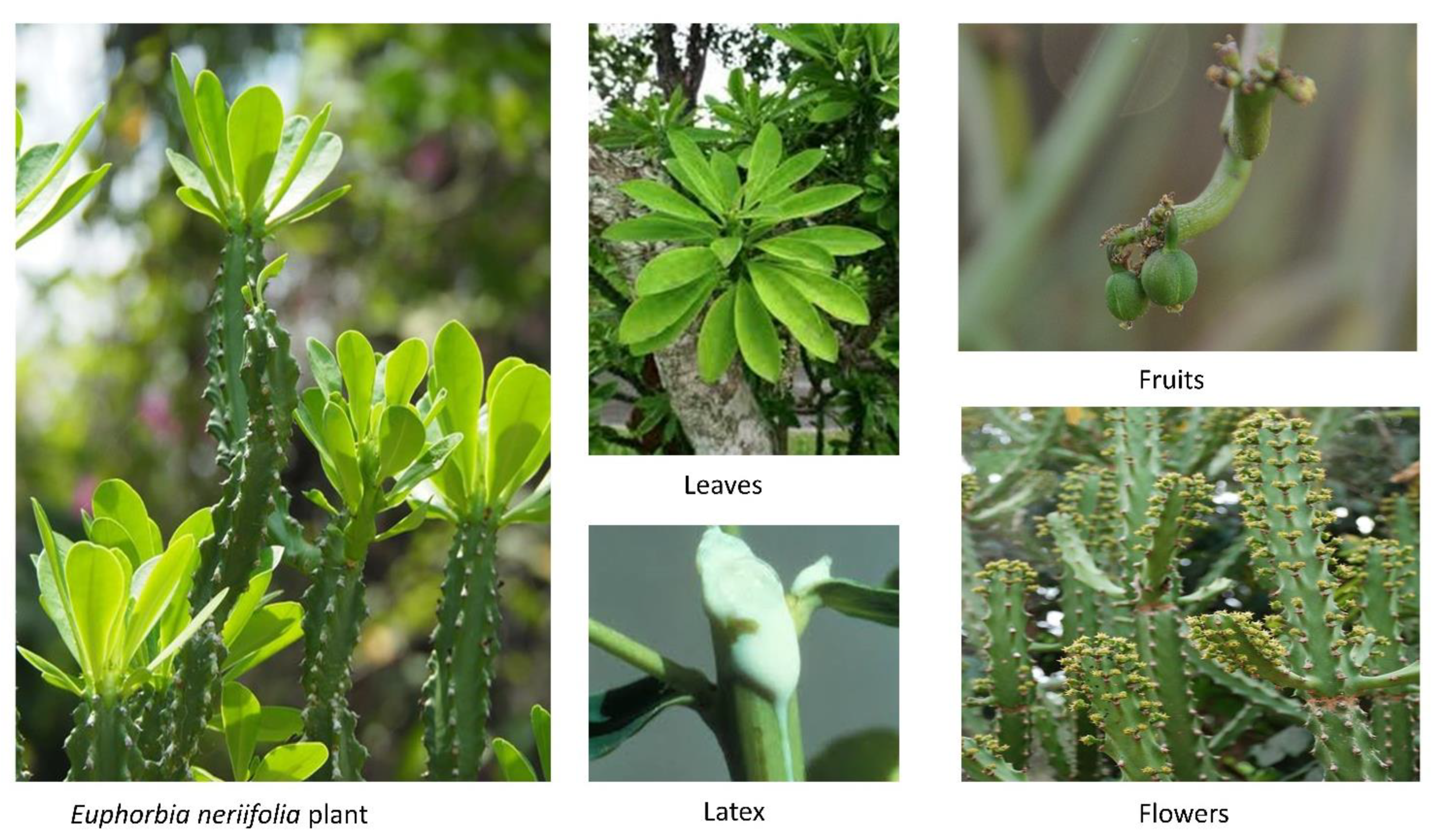Medicinal plants have considerable potential as antimicrobial agents due to the presence of secondary metabolites. Researchers aim to summarize the classification, morphology, and ethnobotanical uses of Euphorbia neriifolia L. and its derived phytochemicals with the recent updates on the pharmacological properties against emerging infectious diseases, mainly focusing on bacterial, viral, fungal, and parasitic infections.
- Euphorbia neriifolia
- phytoconstituents
- traditional applications
- ethnopharmacology
1. Introduction
This plant produces a milky latex that is traditionally used to treat a wide range of diseases, including skin diseases, digestive issues, wounds, hemorrhages, bronchitis, tumors, leukoderma, and so on. The plant also has immunomodulatory, anti-inflammatory, and analgesic properties [1]. Phytochemical analyses resulted in the identification of various classes of secondary metabolites, including Euphol, monohydroxy triterpene, nerifoliol, taraxerol, β-amyrin, glut-5-(10)-en-1-one, neriifolione, and cycloartenol, etc. These compounds are also proven to exhibit a wide range of biological activities [2].
2. Morphology
3.1. Leaves

2.2. Involucres
Yellowish involucres emerge in clusters of three to seven in a cyme, generally in threes, on a very small fleshy peduncle of around 3.8 mm in length. The lateral flowers in the involucre are pedicelled and bisexual, whereas the center blooms are typically male and sessile. Male involucre, 2-bracteate, bearing a bisexual involucre in the bract axils, the opposing bracts of which may carry a peduncle each and are 3-lobed with a serrated central lobe. Involucre lobes are widely cuneate and fimbriate, and anthers are sagittate and apiculate, similar to those of E. nivulia [4].
2.3. Flowers
2.4. Fruits
2.5. Seeds
2.6. Branch
2.7. Stem
2.8. Stippular Thorns
2.9. Glands
2.10. Powder
2.11. Latex
2.12. Taxonomy
2.13. Vernacular Name
-
Sanskrit: Snuhi, Snuk, Svarasana, Nistrinsapatra, Nagarika [2]
-
Tibetan: Si-ri-kha-nda/Snu-ha [2]
-
Malaysian: Sesudu [12]
-
Burmese: Shasaung, Shasoung, Shazawnminna Zizaung [13]
-
Thai: Som chao [12]
-
Philippino: Carambuaya, Karimbuaya, Sobog-sobog, Sobo-soro, Sorogsorog [12]
3. Ethnobotanical Uses
This entry is adapted from the peer-reviewed paper 10.3390/molecules27144374
References
- Ved, D.K.; Sureshchandra, S.T.; Barve, V.; Srinivas, V.; Sangeetha, S.; Ravikumar, K.; Kartikeyan, R.; Kulkarni, V.; Ajith, S. FRLHT’s ENVIS Centre on Medicinal Plants. FRLHT: Bengaluru, India, 2016.
- Bigoniya, P.; Rana, A. A Comprehensive Phyto-Pharmacological Review of Euphorbia neriifolia Linn. Pharmacogn. Rev. 2008, 2, 57.
- Kirtikar, K.R.; das Basu, B. Indian Medicinal Plants; Sudhindra Nath Basu, M.B. Panini Office, Bhuwanéswari Asrama: Bahadurganj, Allahabad, India, 1918.
- Oommachan, M. The Flora of Bhopal (Angiosperms); JK Jain Bros.: Bhopal, India, 1976; pp. 21–25.
- Shah, J.J.; Jani, P.M. Shoot Apex of Euphorbia neriifolia L. Proc. Natl. Inst. Sci. India 1964, 30, 81–91.
- Upadhyaya, C.; Sathish, S. A Review on Euphorbia neriifolia Plant. Int. J. Pharm. Chem. Res. 2017, 3, 149–154.
- Bigoniya, P. Euphorbia Latex: A Magic Potion or Poison. In Traditional and Folk Herbal Medicine: Recent Researches; Daya Publishing House: New Delhi, India, 2012; Volume 1.
- Sharma, V.; Janmeda, P.; Singh, L. A Review on Euphorbia neriifolia (Sehund). Spatulla DD 2011, 1, 107–111.
- Sharma, V. Microscopic Studies and Preliminary Pharmacognostical Evaluation of Euphorbia neriifolia L. Leaves. Indian J. Nat. Prod. Resour. 2013, 4, 348–357.
- Zhang, D.; Wu, K.; Zhang, X.; Deng, S.; Peng, B. In Silico Screening of Chinese Herbal Medicines with the Potential to Directly Inhibit 2019 Novel Coronavirus. J. Integr. Med. 2020, 18, 152–158.
- Gaoue, O.G.; Yessoufou, K.; Mankga, L.; Vodouhe, F. Phylogeny Reveals Non-random Medicinal Plant Organ Selection by Local People in Benin. Plants People Planet 2021, 3, 710–720.
- Ahmed, S.A.; Nazim, S.; Siraj, S.; Siddik, P.M.; Wahid, C.A. Euphorbia neriifolia Linn: A Phytopharmacological Review. Int. Res. J. Pharm. 2011, 2, 41–48.
- Shamim, S.A.; Fatima, L. Pharmacological Actions and Therapeutic Benefits of Thuhar (Euphorbia neriifolia): A Review. World J. Pharm. Res. 2018, 10, 1337–1349.
- Mali, P.Y.; Panchal, S.S. Euphorbia Neriifolia L.: Review on Botany, Ethnomedicinal Uses, Phytochemistry and Biological Activities. Asian Pac. J. Trop. Med. 2017, 10, 430–438.
- Pracheta, S.V.; Paliwal, R.; Sharma, S. Preliminary Phytochemical Screening and in Vitro Antioxidant Potential of Hydro-Ethanolic Extract of Euphorbia Neriifolia Linn. Int. J. PharmTech Res. 2011, 3, 124–132.
- Hasan, M.; Ganeshpurkar, A.; Bansal, D.; Dubey, N. Protective Effect of Euphorbia neriifolia Extract on Experimentally Induced Thrombosis in Murine Model. Niger. J. Exp. Clin. Biosci. 2014, 2, 86.
- Yen, G.-C.; Chen, H.-Y. Antioxidant Activity of Various Tea Extracts in Relation to Their Antimutagenicity. J. Agric. Food Chem. 1995, 43, 27–32.
- Khare, C.P. Indian Medicinal Plants: An Illustrated Dictionary; Springer Science & Business Media: New Delhi, India, 2008; Available online: https://books.google.com.bd/books?hl=en&lr=&id=gMwLwbUwtfkC&oi=fnd&pg=PA1&dq=Glossary+of+Indian+Medicinal+Plants.+&ots=_DCZB3B_QM&sig=3RVYftLogJIwdajjeXEJnqhJ9AM&redir_esc=y#v=onepage&q=Glossary%20of%20Indian%20Medicinal%20Plants.&f=false (accessed on 1 January 2022).
- Sharma, D.K. Bioprospecting for Drug Research and Functional Foods for the Prevention of Diseases—Role of Flavonoids in Drug Development; CSIR: New Delhi, India, 2006; Available online: http://nopr.niscpr.res.in/handle/123456789/4836 (accessed on 1 January 2022).
- Sharma, G.K.; Dhanawat, M. Effectual Qualitative Chemical Evaluation of Euphorbia Neriifolia Linn. by Using Fluorescence Analysis. J. Drug Deliv. Ther. 2019, 9, 44–47.
- Radhakrishna, S. Multicentric Randomized Controlled Clinical Trial of Kshaarasootra (Ayurvedic Medicated Thread) in the Management of Fistula-in-Ano. Indian J. Med. Res. Sect. B Biomed. Res. Other Than Infect. Dis. 1991, 94, 177–185.
